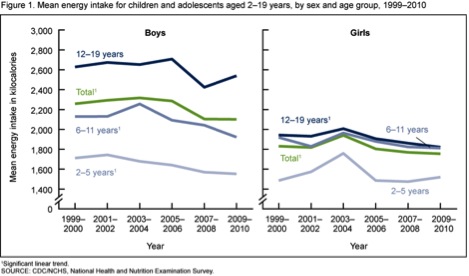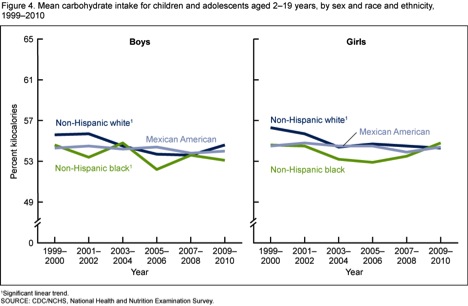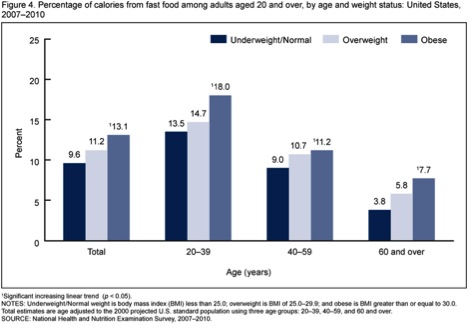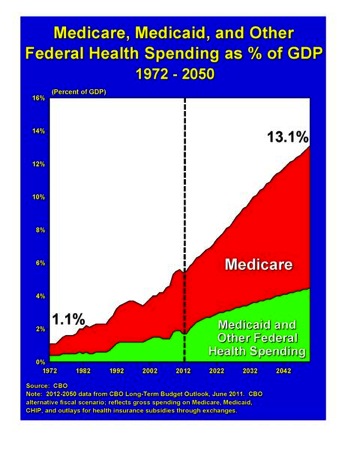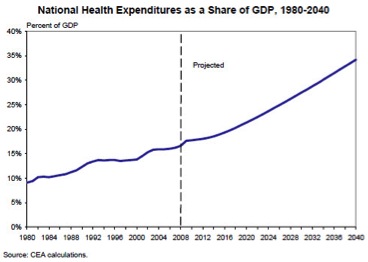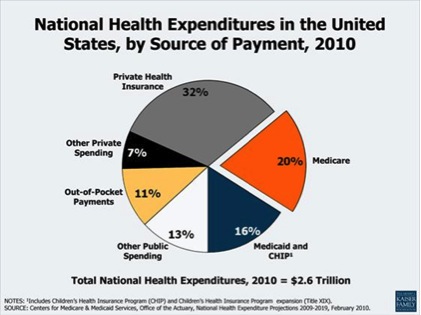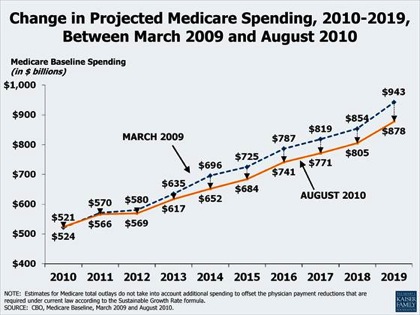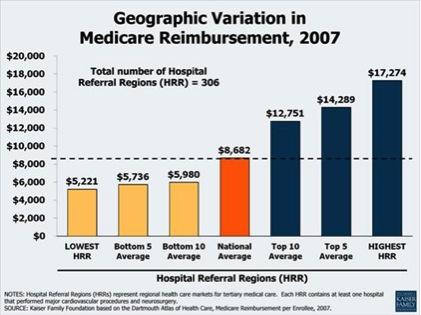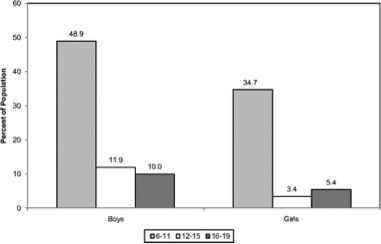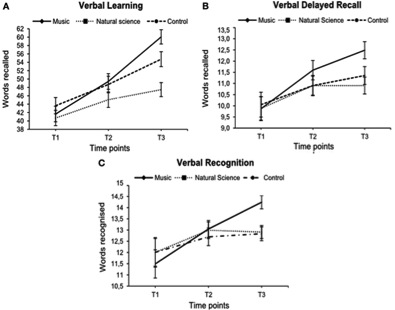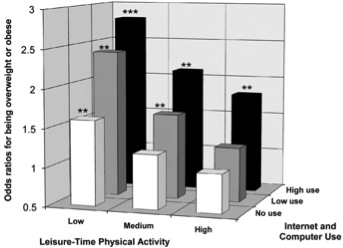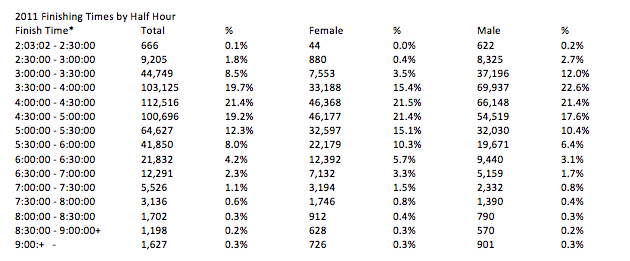Archive for February, 2013
The Beginning of Good News on Obesity?
There are two recent reports from the United States Center for Disease Control about obesity and calorie consumption that make me a bit more optimistic that the obesity epidemic might be cresting. The first report shows what looks like the beginning of a decline in calorie consumption by kids over the last 10 years but especially during the last 5 years. The figure below is taken from this report. There are all sorts of caveats about this data but it is promising and seems to correlate with the idea that childhood obesity is leveling off and perhaps even declining a bit in some regions. However, there were differences in various ethnic groups.
The next figure from the report shows that much of the change in overall calorie consumption is a result of a decline in carbohydrate consumption among whites. This might be a result of efforts to reduce the consumption of sugary drinks that are working in that subgroup or the population.
The second report is about adults and it focuses on who is eating how much fast food and what the impact of this consumption is on obesity. The next figure shows more fast food consumption by obese individuals in every age group. Again there are caveats with this data, but the message is pretty clear that consuming a lot of fast food is a big risk factor for obesity. If you want to read more about how people get addicted to certain types of food, here is a link to a long article from the New York Times on how the food industry has learned to develop products that really tickle our taste buds and leave us craving even more.
A Personal Experience & These Findings
I am somewhere between 6’4” and 6’5” (195 cm). At the end of August I weighed about 205 pounds (92.5kg). About that time my wife got the junk food (notably chips, crackers and ice cream) out of the house. I also started to limit my consumption of Dr. Pepper from about 1-2 cans per day to a couple per week and when hungry at work I now snack on either protein bars or apples and bananas. Since that time I have lost about 8 pounds (3.5kg). We were also pretty disciplined about having a few holiday treats, but after a cookie or two, trashing the rest. As you might imagine I am pretty physically active, but this time of year I am less active because I stop riding my bike to work when the roads get icy in November. So, this weight loss happened during a time of the year I have typically gained a couple of pounds (1kg) in the past, and I have seen a direct correlation between what the data in the charts tells us and my own body weight. The take home messages from all of this might go something like this:
- Groups and individuals who reduce their consumption of sugar and fast food/junk food lose weight, don’t gain weight, or don’t gain as much weight. All good things.
- If you are physically active, small changes in your diet can make a big, big difference. When in doubt have an apple. If you do get the junk food out of the house and moderate what you eat when not at home the weight seems to come right off.
- After a couple of months of change I don’t miss having a bowl of ice cream at night.
- Small changes over time make a big difference.
Good luck with your goals and I want to emphasize again that a collection of small changes over time can make a big difference whatever your goals.
Health Care Spending Facts & Sequestration
As part of the political trench warfare over taxes, spending and the long term federal debt the next big hurdle is so called “sequestration” on March 1st. If the President and Congress can’t agree on a combination of spending cuts and tax increases then a series of automatic cuts will take place. Behind all of this bickering is one simple fact. Medicare and other federal health care spending has risen from a tiny fraction of the federal budget to about 20% and is slated to continue to grow as the baby boomers retire. In this post I want to give you some background information via 5 slides that will be useful to frame later discussions about what to do about Medicare in specific and health care in general. The figure below comes from the Senate Budget Committee and shows key trends and future projections as a % of GDP. Also remember the U.S. spends a higher fraction of our GDP (about 18%) on health care than any country in the world.
Overall Health Care Spending
The next figure is from a White House report in 2008 (before Obamacare) and it shows what is projected to happen to total health care spending in the U.S. economy well into the future in the absence of significant “reform”.
An Unbiased Look at Medicare
For anyone want to take a deep dive into Medicare, the Kaiser Family Foundation has a series of slide shows on Medicare that cover almost every element of the program starting from the late 1960s. That having been said, I want to share three of the more than 120 slides posted on their website.
Kaiser Slide 1: “The Government” Pays 50% of the Bill.
The first slide is for anyone who has any doubt about just how much of the nation’s health care bill is paid for by the “government”. The magic number was roughly 50% in 2010 when you add up all programs (including employee benefits) at every level of government. So everyone needs to accept the fact the government involvement in health care is here to stay and we need to focus on how to deploy these resources in smarter ways.
Kaiser Slide 2: Does Obamacare Bend the Cost Curve?
The next slide shows projected Medicare spending until 2019. The top line was pre Obamacare and the bottom line includes assumptions about costs savings as a result of it. The key point is that Obamacare does not move the needle that much. Additionally, the continuous upward trend shown in the 2008 White House slide above suggests that the many efforts at cost containment since 1980 have had limited effects on the growth of spending. In a later post I will discuss how much things like price controls, bundling, and potentially limiting access to technology have done so far when the “heavy hand of the Feds” has attempted to intervene to reduce the rise in health care spending (the short answer is not much).
Kaiser Slide 3: Medicare Spending is All Over the Map!
The final slide shows how average Medicare spending varies more than threefold depending on where someone lives. The reasons for this variation have been debated and are complicated but overuse of services (e.g. doing things of little or no benefit to patients) is a major cause. This data also suggests that if more conservative and coordinated practice styles were adopted nationally there could be substantial cost savings for the country with no decrement in the quality of care provided to patients.
Summary
Health care spending in general and Medicare spending are complicated and emotional topics. The points I want to emphasize via the 5 slides above include:
- Spending is rising and the trends are not sustainable.
- The “government” is heavily involved in medical spending.
- There is wide regional variation in spending per patient that is not related to patient outcomes.
In future posts I will offer some ideas about what could be done to restrain government spending on medical care and help solve the long term budgetary challenges associated with these spending trends. Believe it or not there is one federal program that is a relative model of efficiency. More on that later, but there are models out there that work.
Bernard Lagat vs. Aging
Last weekend 38 year old Bernard Lagat, a multiple Olympic medalist in the 1500m, broke the American record for the indoor 2-mile run at the Millrose games in New York City. His time was just over 8:09. This prompted Nick Thompson of the New Yorker to post an excellent piece “Will Bernard Lagat Live Forever?” It highlighted a number of things about Lagat, a native of Kenya who now competes for the United States, and I was able to provide a bit of physiological insight for Mr. Thompson into why such a great performance was possible by such and “old” runner. In this post I want to take a bit of deeper dive into: a) just how unusual this performance is, b) some of the physiology behind it, and c) how long Lagat might continue to run fast.
A Fast Time by a 38 Year Old?
Every time someone in their late 30s or early 40s runs, swims, or rides a bike fast it causes a stir. That having been said the first thing to remember is that this is not unprecedented. Here is a top of my head list of other examples of people who have run very fast in their late 30s or early 40s (there are Wiki sites on all of these folks).
- Jack Foster – multiple fast marathons in his late 30s and early 40s.
- Carlos Lopes — 1984 Olympic marathon champ at age 37
- Francie Larrieu (Smith) – 5 time Olympian, last at age 40
- Steve Scott – broke 4 minutes for the mile 136 times, the last when he was 37
- Eamonn Coughlin – broke 4 minutes at age 41
- Haile Gebrselassie – set the world record for the marathon at age 35
- Miruts Yifter – gold medals in the 5k and 10k in 1980 when he as at least 36
- Constantina Diţă — won the Peking Marathon in 2008 at age 38
The 2-Mile Run is a Max Test!
It turns out a 2-mile run is essentially a VO2 max test and highly dependent on the maximum ability of the body to deliver oxygen to the exercising muscles. In fact the velocity at VO2 max on a flat incremental treadmill test to exhaustion is a great predictor of 3k or 2-mile time. This measurement also considers running economy because more efficient or economical runners will go faster while consuming a given amount of oxygen. The other thing to remember here is that while VO2 starts to fall at age 30 in untrained subjects it is both much higher and starts to fall later in the super fit who continue to train hard and do intervals.
What About Lagat, and How Fast for How Long?
Lagat is a relatively light trainer in terms of his weekly mileage, but he runs his mileage fast and does the type of interval training critical for maintaining a high VO2 max as you age. He also ran very fast indoor 3k times in 2010 and 2012, so fast times in races lasting about 8 minutes are nothing new. His relatively light training also probably protects him from physical injury and psychological burn out. All of this is consistent with information I shared in a previous post on running fast while getting older. So the only question is how much longer can these fast times last? The short answer is who knows, but longitudinal data on elite male distance runners over 20 plus years shows that those who continue to train intensely lose the least and those who train the hardest (not the most) lose almost nothing (2%) into their middle to late 40s. So, if Bernard Lagat wants to keep running fast, there is no physiological reason he can’t be running almost as fast as he is now for at least five more years. 1% of a fast 2-mile is about 5 seconds and somewhere under 8:20 would certainly seem possible for Lagat 5 years from now. He would only be 43!
Exercise, Cognition & Conscientiousness
My last two posts have focused in part on the relationship between physical activity and cognitive function. Today I want to make two simple points and connect them. The first is from another Cooper Clinic database study and looks at the association between midlife physical fitness in about 20,000 people and a later diagnosis of dementia. The subjects were divided into fitness quintiles and followed for about 25 years. The figure below shows that individuals in the highest fitness quintiles had only about 64% of the risk of a dementia diagnosis compared to the least fit subject. Importantly, the level of exercise training needed to move up several fitness quintiles is modest and consistent with standard physical activity guidelines for adults, e.g. 150 minutes per week of vigorous walking.
The second point I want to make is that a psychological trait known as conscientiousness is also associated with healthy aging and a modest increase in longevity. In a longitudinal study of aging conducted in about 2,400 residents of Baltimore, Maryland who were followed for five decades, people who scored high for conscientiousness lived longer. General activity, a marker of who is extroverted or “outgoing”, and emotional stability were also traits associated with living 2-3 years longer.
There are a couple of ways fitness and conscientiousness might be connected. The first is pretty straight forward and perhaps conscientious people just plain exercise more and generally follow health and lifestyle related guidelines about exercise, diet, not smoking and things like wearing seat belts. The second explanation is a bit more subtle and relates to the effects of exercise on something called executive functions. If exercise and physical activity enhance areas of the brain involved with executive functions — the ability to plan, stay on task, and pay attention — then people might be more likely to engage in healthy activities over time. If exercise helps maintain executive functions as we age then perhaps it is “easier” or more automatic for people to continue to stay fit as they age. So perhaps this is not so much about fixed personality traits as it is about exercise and conscientiousness reinforcing or amplifying a positive suite of behaviors over time.
None of this would surprise my grandmother who was born in the early 1900s and ultimately became a pioneer special education teacher in rural Indiana. She made sure all of her grandchildren and just about every other young person she came in contact with was exposed to books like The Little Engine That Could. I am sure she would not be surprised by the idea that good habits and a positive attitude generate more good habits and a positive attitude over time. To her that was a fundamental piece of Midwestern common sense.
Are Humans Going to Get Dumber?
This post is going to be discursive and ramble a bit, but bear with me and I think the ideas I am trying to integrate will come together for you. In my last post I reviewed some data about how exercise can improve academic achievement in kids along with the lifetime implications of physical fitness in childhood on brain health as we age. That got me thinking about a number of questions.
1. Will the world get dumber as people get less active?
Here is a figure from the American Heart Association showing the percent of kids in various age groups meeting the guidelines for daily physical activity. What will the long term implications of all of this inactivity be on the intelligence of society as a whole? Will all of this inactivity lead to a whole lot more fuzzy old people in the future suffering from various forms of cognitive impairment as they age?
2. What about forms of enrichment other than exercise?
The data on the effects of school based music lessons on cognitive performance is pretty impressive, and music education early in life seems to have long lasting effects on the brain even if you don’t continue to play and practice into adulthood. The figure below is from the music lesson study that:
“….examined the effects of a school-based instrumental training program on the development of verbal and visual memory skills in primary school children. Participants either took part in a music program with weekly 45 min sessions of instrumental lessons in small groups at school, or they received extended natural science training. A third group of children did not receive additional training. Each child completed verbal and visual memory tests three times over a period of 18 months. Significant Group by Time interactions were found in the measures of verbal memory. Children in the music group showed greater improvements than children in the control groups after controlling for children’s socio-economic background, age, and IQ. No differences between groups were found in the visual memory tests. These findings are consistent with and extend previous research by suggesting that children receiving music training may benefit from improvements in their verbal memory skills.”
3. What about electronics?
The exercise and music lesson data might be interpreted in a very broad way to mean that doing things makes us smarter. Will the same apply for our interactions with the electronic environment that surrounds and invades us? This has been the topic of discussion in a number of venues and there are so-called smartphone holdouts who are worried that being connected to a computer will make them dumber. For example “in the old days” people used to routinely memorize phone numbers they called frequently. It seems to me that in the days of cell-phone speed dial and contact lists no one needs to memorize anything. Maybe this will just free up mind space for other things, or maybe it will make us dumber because our memory needs to be used and the ability to memorize trivial things is in fact a building block for higher order thinking and intellectual skills. In a similar vein, no one can do math in their head anymore……… those of us who grew up doing timed running or swimming workouts got very good at doing math in our heads as we calculated various split times and converted minutes to seconds depending the distance we were running or swimming. What about video games? A colleague of mine Dr. Bill Lanier commented that:
“My mother, who is a former college professor in education, says that if you only learn by having multi-modal input that incorporates sound, brilliant lights, movement, etc. (eg., video games), then you lose your ability to pick up a boring old book and envision what it is like to have characters move, speak, and interact.
Is the future a future with no memory, no math in our head, and no imagination?
4. Will electronics make us less active?
The figure below shows the interactions between screen time and physical activity and the odds of being overweight in adults. The authors of this study concluded:
“These findings suggest that, apart from nutritional and physical activity interventions, it may also be necessary to decrease time spent in sedentary behaviors, such as leisure-time Internet and computer use, in order to reduce the prevalence of overweight and obesity………Longitudinal studies are required to examine further the potential causal relationships between the development of overweight and specific sedentary behaviors such as Internet and computer use.”
I would add the combination of no physical activity and the frequently passive nature of the electronic environment could be a double hit to our collective intelligence for the reasons outlined above.
5. How much decision support is enough?
The ideas above are all about the negative interactions of physical and intellectual passivity. How far will this go? At some the level “the machines” are increasingly taking over both routine decisions via things like collision avoidance systems in cars, but the machines are also making us potentially passive bystanders in much more important things via so-called decision support. To take a bit of a leap, the recent debate on who decides about lethal military drone strikes highlights a number of issues about where this all might lead. Forget for the moment the moral and ethical issues associated with killing, what constitutes the battlefield, and who is a combatant. Imagine instead when the drones are programed with algorithms to support the remote pilots in deciding when to “pull the trigger”. The next step will be a statistical comparison of what the humans decided to do vs. what the algorithms “suggested”. What happens when there is no statistical difference? What happens if evidence emerges that is pitched in the context of the drones being “more reliable”. How soon until we give up life and death decisions to the algorithms?
6. The end of creativity?
Another issue with decision support is that it seems to me that it can be used primarily to make the known way or ways of doing things better. Imagine if decision support techniques had been applied to high jumping in the early 1960s. Detailed data on the biomechanics of how people jumped, their physical characteristics, and how they trained could all be collated and the ideal higher jumper could be identified and trained accordingly and incremental improvements made. But, what happened instead was as teenagers who “knew nothing”, Dick Fosbury and Debbie Brill, invented an entirely new way to jump that was revolutionary. The video below if of Dick Fosbury winning the gold medal in the high jump in 1968. Here is link to an extended to an interview with Fosbury.
click here for video
Summary:
I am not sure where all of this leads us, but I am sure that humans are designed to be mentally and physically active and we should be very careful both as individuals and a species about how much we stop doing at all levels. This includes being too physically inactive, having too much passive screen time, and turning over too many decisions to the machines.
Exercise and School Performance
Last Fall I reviewed some of the risk factors, including inactivity, for Alzheimer’s disease and cognitive decline with aging. In this short post I want turn the discussion around and highlight a couple of things related to cognitive or even school performance and physical activity in kids. My interest in this topic was stimulated by a news report of a study in Denmark showing that kids who walk or ride their bikes to school concentrate better. This stimulated me to look a little more about what research tells us about physical activity and school performance.
Study 1: Walk and read better.
A single 20 minute session of brisk treadmill walking improves academic performance in pre-adolescent children especially reading comprehension. Here is a figure from that study. The filled bars are the scores after walking and the open bars are the control scores.
The authors concluded that:
“Collectively, these findings indicate that single, acute bouts of moderately-intense aerobic exercise (i.e. walking) may improve the cognitive control of attention in preadolescent children, and further support the use of moderate acute exercise as a contributing factor for increasing attention and academic performance. These data suggest that single bouts of exercise affect specific underlying processes that support cognitive health and may be necessary for effective functioning across the lifespan.”
Study 2: A review of physical activity and academic achievement.
This paper is a review of ideas about the so-called academic achievement gap in school performance by some ethnic and socioeconomic groups. Based on the data surveyed the following conclusions emerged:
“Physical inactivity is highly and disproportionately prevalent among school-aged urban minority youth, has a negative impact on academic achievement through its effects on cognition, and effective practices are available for schools to address this problem. Increasing students’ physical activity and physical fitness can best be achieved through a comprehensive approach that includes physical education, wise use of recess and after-school times, co-curricular physical activity opportunities, and bicycling or walking to and from school.”
Study 3: Exercise helps kids with ADHD focus.
This study used a walking protocol similar to study one highlighted above in 20 children (8-10 years old) with ADHD and found:
“Following a single 20-minute bout of exercise, both children with ADHD and healthy control children exhibited greater response accuracy and stimulus-related processing, with the children with ADHD also exhibiting selective enhancements in regulatory processes, compared with after a similar duration of seated reading. In addition, greater performance in the areas of reading and arithmetic were observed following exercise in both groups. These findings indicate that single bouts of moderately intense aerobic exercise may have positive implications for aspects of neurocognitive function and inhibitory control in children with ADHD.”
Summary: Physical activity is emerging as a key modulator of academic performance and learning among children of all sorts. It also appears to be a gift that will keep giving. In a study from Scotland, 11 year old children studied in 1933 and also studied again 68 years later at age 79 showed that physical fitness early in life was associated with successful cognitive aging. The policy implications of the findings highlighted above for things like physical education in school, recess and public policies aimed at getting kids moving are pretty striking. If we want a smarter world we need a fitter world.
Will Big Data Win?
It has been a few weeks since I posted on larger societal issues like longevity or the U.S. Federal Budget. However, a recent column by David Brooks in the New York Times on “Big Data” caught my eye. The idea is that in the electronic world there is all sorts of data out there that can be analyzed and that many of the ways we think and many of the assumptions we make don’t hold up when analyzed. As early as the 1980s people started to evaluate the idea of the “hot hand” in basketball and found the widely accepted idea that people go on hot streaks is not accurate. Brooks goes on to highlight a number of areas where the data from various sources is being used to challenge long held ideas or conventional wisdom.
One problem with the current infatuation with “data” is that we don’t always know much about the quality of the data. This has been acknowledged by IBM, a company that has made a major push into the business of what is generically known as analytics:
“The volume of data produced today isn’t just increasing—it’s getting faster, taking more forms and is increasingly uncertain in nature. Uncertainty arises from such sources as social media, imprecise data from sensors and imperfect object recognition in video streams. IBM experts believe that by 2015, 80 percent of the world’s data will be uncertain.”
We see this all of the time in medical research where information gleaned from clinical records has to be scrubbed before it can be used in a meaningful way to address a scientific question. It is also possible to be “led astray” using observational or easily available data. There are a number of high profile examples of medical practices based on observational data did not hold up or were reversed when they were tested in a more rigorous fashion using a more controlled approach. One of the best examples is post-menopausal hormone replacement therapy. However, this remains controversial and full of nuances, so the more we know sometimes the more we don’t know.
The other issue here is that all the data in the world is no substitute for judgement. I have used the example of Robert McNamara in the past and his “data driven” approach to “managing” the war in Vietnam. I would urge everyone interested in the limits of number crunching and metrics to watch the Fog of War. As the clip below points out, if your fundamental assumptions are wrong all of the data in the world will not help you get it right.
The final and perhaps more optimistic point I want to make is that sometimes an off the wall anti-metric approach is so disruptive that it wins and is incredibly successful. The ideas about a hot hand in basketball aside, for those of you interested in really thinking differently the ESPN 30 for 30 “Guru of Go” on Paul Westhead and Loyola Marymount’s ultra-fast style of basketball is instructive. Westhead was a traditional coach focused on defense, ball-control, getting a good shot and minimizing turnovers until he realized there was a faster and more chaotic (yet organized) way to play.
Summary: The current obsession with metrics, data driven approaches, analytics and big data need to be taken with more than one grain of salt. Sometimes it is the stuff you can’t measure that really counts. All of us who value freedom and democracy are lucky that Winston Churchill was not concerned with the “metrics” of World War II when Britain stood alone and all seemed lost in 1940. As the psychiatrist/historian Anthony Storr pointed out:
If history is any lesson, then perhaps the important questions for the future are less about data and more about judgement.
Physical Fitness Testing & Combat
Recent policy changes in the U.S. military will allow women to serve in so-called combat units. There is some skepticism about this related in part to the idea that women may not be able to do all of the physically demanding things required to qualify for assignment to these units. This is especially true for the most physically demanding jobs in things like the Special Forces.
What are the standards?
Standards vary by service but here is a link to the basic fitness standards for the U.S. Marines. I am using the Marines for the purpose of this discussion because they have been very open in discussing the “Women in Combat” issue and because the Marines place extra emphasis on fitness by all members of the Corps. Here is what it takes to get a perfect 300 on the fitness test for a Marine in the 17-26 year old age group (the standards are age adjusted) and also the minimum standards.
To earn a perfect PFT score of 300 points, a male must do 20 pull-ups, 100 crunches in less than two minutes, and complete the three mile run in 18 minutes or less. A female perfect score is 70 seconds on the flexed arm hang, 100 crunches, and a 21 minute three mile run. The minimum a male Marine must complete are 3 pull-ups, 60 crunches, and a 28 minute (9:20 pace) 3-mile run. The minimum a female Marine must complete are 15 seconds on a flexed arm hang, 44 crunches and a 31 minute (10:20 pace) 3-mile run.
The Running Standards vs Marathon Times
How do the minimum running standards above compare to something like the average pace for the marathon? Here is some summary data from about 520,000 marathon finishes recorded 2011.
Remember these times represent all comers and when you compare them to the 3 mile pace standards for young Marines listed above it is pretty clear that all sorts of people could in fact meet the Marine Corps minimum standards for the three mile run. Based on years of watching people improve as they train, my rough guess is that many males in their 20s could break 21 minutes for three miles and many females in their 20s could break 24 minutes.
The data below is a further breakdown of the marathon data and about 30% of men break 4 hours (9:10 pace) and almost 20% of women do. There are all sorts of caveats about this data including people could have run multiple races and some of the times include delays while runners farther in the back pack got to the starting line. The data is not also broken down by age. However, I would say this data clearly proves that many women could meet the running standards for combat units.
Strength
There is nothing like the data above for strength differences in men and women as assessed by things like pull-ups and push-ups. We don’t see thousands or people participating in massive group events and competitions to see “who can do how many” all over the world like we do for running and the marathon. However, a few rigorous training studies suggest that young women can improve remarkably and that many could meet current standards with training:
“Strength training improved physical performances of women over 6 months and adaptations in strength, power, and endurance were specific to the subtle differences (e.g., exercise choice and speeds of exercise movement) in the resistance training programs (strength/power vs strength/hypertrophy). Upper- and total-body resistance training resulted in similar improvements in occupational task performances, especially in tasks that involved upper-body musculature. Finally, gender differences in physical performance measures were reduced after resistance training in women, which underscores the importance of such training for physically demanding occupations.”
That having been said, my bet is that with intensive training, plenty of women would be able to meet current body weight specific tests of strength. Whether the distribution would be similar to that for running is not clear, but the point is plenty of women could qualify.
Special Forces
The table above also provides some insight into what happens if the standards are really tough as they are for the Special Forces in various services. If you set physical standards that less than 1% of men can meet then perhaps only 0.1% of women will be able to meet them. Until you get to the fastest of the fast or the strongest of the strong do you see things that “no woman” can do. The figure below makes that point for the marathon (42,000m) and 1,500m times.
This is an Old Issue!
In the 1970s my teacher Jack Wilmore was asked to evaluate whether women could ever be fit enough to serve in the California Highway Patrol. Many of the arguments about physical strength and fitness as they relate to women in combat echo the arguments made about police and firefighter work in the 1970s and 80s. In a classic study Dr. Wilmore made a number of observations including the fact that many police officers were in poor physical condition once they finished training. He also advocated task specific fitness tests, and noted that:
“….there were overlaps between the range of values for each task for males and females, indicating some women were performing better than some men. The authors feel strongly that a screening test battery must be nondiscriminatory both on the basis of age and sex.”
Summary
The data from exercise physiology and sports performance studies clearly indicate that with training there will be many women who can pass the rigorous physical fitness tests required for assignment to many combat units and combat related jobs in the U.S. military. The only exception to this conclusion might be seen in the Special Forces with physical fitness standards similar to those seen in truly elite athletes. I will leave the political, philosophical, and religious discussions about women in combat to others. However, from a physiological perspective there is no reason to bar women from combat, and there is no reason to believe many women will not qualify and excel.
You are currently browsing the Human Limits blog archives for February, 2013.

